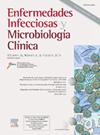Prevalence, risk factors for and trends in faecal colonisation by extended-spectrum beta-lactamase-producing Enterobacterales (ESBL-PE) in the community in Spain: A cross-sectional study and meta-analysis
IF 2.5
4区 医学
Q3 INFECTIOUS DISEASES
Enfermedades infecciosas y microbiologia clinica
Pub Date : 2025-06-01
DOI:10.1016/j.eimc.2024.10.009
引用次数: 0
Abstract
Objectives
To determine the prevalence of and risk factors for extended-spectrum beta-lactamase-producing Enterobacterales (ESBL-PE) faecal carriage among healthy volunteers from Barcelona, and to estimate the pooled prevalence in the community in Spain.
Methods
University students were asked to complete a questionnaire and provide a rectal swab, which was tested for ESBL-producing, ciprofloxacin- and trimethoprim–sulfamethoxazole-resistant Enterobacterales. Risk factors for carriage of antimicrobial resistance were identified by multivariate logistic regression. To place these results in the appropriate context, a systematic literature search was conducted to retrieve articles containing data on the prevalence of ESBL-PE faecal carriage in the community in Spain. To obtain the pooled prevalence, a random-effects meta-analysis was performed.
Results
One hundred and thirty-five of 214 participants were included in the analysis. Faecal carriage of Escherichia coli/Klebsiella pneumoniae (E/K) resistant to at least one of the antibiotics tested was found in 32 participants (23.7%). Fourteen subjects carried ESBL-E/K (10.4%), with the CTX-M type being the most prevalent (85.7%). Risk factors for ESBL carriage were travel to a high-risk region in the past 3 years (OR 5.66; 95% CI 1.07–29.9) and living in a crowded city district (OR 6.91; 95% CI 1.22–39.08). Thirteen articles covering 21,760 individuals from Spain were included in the meta-analysis, giving a pooled prevalence rate for ESBL-PE carriage in the community of 5.8% (95% CI 4.1–7.8%), and a steady increase per year.
Conclusions
The faecal colonisation prevalence by ESBL-PE among healthy individuals in Spain is high. It is associated with international travel and living in crowded city districts.
西班牙社区产广谱β -内酰胺酶肠杆菌(ESBL-PE)粪便定植的患病率、危险因素和趋势:一项横断面研究和荟萃分析
目的了解巴塞罗那健康志愿者广谱产β -内酰胺酶肠杆菌(ESBL-PE)粪便携带的流行情况及危险因素,并估计西班牙社区的总流行情况。方法要求大学生填写问卷,并提供直肠拭子,检测产生esbls、环丙沙星和甲氧苄氨嘧啶耐药肠杆菌。采用多因素logistic回归分析确定细菌耐药的危险因素。为了将这些结果置于适当的背景下,进行了系统的文献检索,以检索包含西班牙社区中ESBL-PE粪便携带流行率数据的文章。为了获得合并患病率,进行了随机效应荟萃分析。结果214名参与者中有135人被纳入分析。32名参与者(23.7%)发现粪便中携带对至少一种抗生素耐药的大肠杆菌/肺炎克雷伯菌(E/K)。14例患者携带ESBL-E/K(10.4%),其中以CTX-M型最常见(85.7%)。携带ESBL的危险因素是过去3年内去过高危地区(OR 5.66;95% CI 1.07-29.9)和居住在拥挤的城市地区(OR 6.91;95% ci 1.22-39.08)。荟萃分析纳入了来自西班牙的13篇文章,涵盖21,760名个体,得出社区中esble - pe携带的总患病率为5.8% (95% CI 4.1-7.8%),并且每年稳步增长。结论西班牙健康人粪便中ESBL-PE定殖率较高。它与国际旅行和生活在拥挤的城市地区有关。
本文章由计算机程序翻译,如有差异,请以英文原文为准。
求助全文
约1分钟内获得全文
求助全文
来源期刊
CiteScore
2.10
自引率
8.00%
发文量
194
审稿时长
29 days
期刊介绍:
Hoy está universalmente reconocida la renovada y creciente importancia de la patología infecciosa: aparición de nuevos agentes patógenos, de cepas resistentes, de procesos con expresión clínica hasta ahora desconocida, de cuadros de una gran complejidad. Paralelamente, la Microbiología y la Infectología Clínicas han experimentado un gran desarrollo como respuesta al reto planteado por la actual patología infecciosa. Enfermedades Infecciosas y Microbiología Clínica es la Publicación Oficial de la Sociedad Española SEIMC. Cumple con la garantía científica de esta Sociedad, la doble función de difundir trabajos de investigación, tanto clínicos como microbiológicos, referidos a la patología infecciosa, y contribuye a la formación continuada de los interesados en aquella patología mediante artículos orientados a ese fin y elaborados por autores de la mayor calificación invitados por la revista.

 求助内容:
求助内容: 应助结果提醒方式:
应助结果提醒方式:


